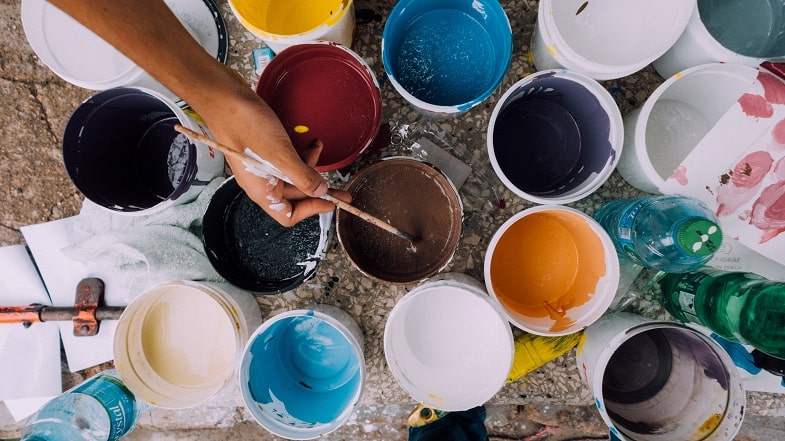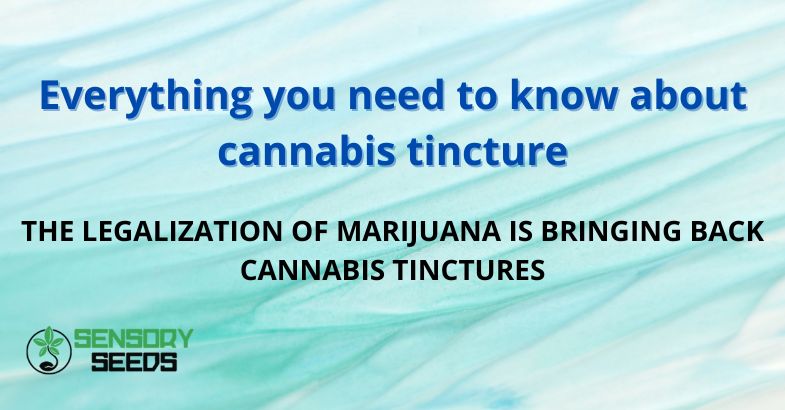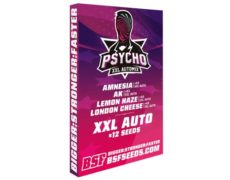Published on: 09/10/2023
THE LEGALIZATION OF MARIJUANA IS BRINGING BACK CANNABIS TINCTURES
For some time the Italian market has known the appearance of many items related to marijuana, a plant demonized for decades, but which is currently the protagonist of a rediscovery that is pushing more and more countries to activate paths of gradual legalization, abandoning the traditional prohibitionist policies.
Something similar is also happening in the UK, where the trade of items such as cannabis seeds and legal hemp for collecting purposes has been allowed for several years now. However, in our country there is still a certain adversity towards other marijuana-based products, even towards those that, elsewhere, are experiencing a marked increase in their popularity, such as cannabis tinctures.
In the following article we will delve into the nature and use of the latter, briefly examining their history, the different types of tinctures available, the duration of the effects and their preparation.
What are cannabis tinctures?
A tincture is traditionally a phytotherapeutic, homeopathic or cosmetic solution containing an active drug, or parts of a non-dried plant, and a solvent, which can be used as a base for more complex solutions or as a finished product.
You’ve probably used these solutions before: think mercurochrome or iodine-based disinfectants, the brown ones often found in first aid kits. Here, those are, precisely, tinctures.
Those of cannabis are stored in glass bottles equipped with droppers and are obtained from simple plant material from marijuana immersed in strong and filtered alcohol. In this way terpenes and cannabinoids such as THC or CBD can be extracted from the plant. The liquid thus obtained, in countries where the consumption of such products is permitted (therefore, not in the UK) can be ingested orally or sublingually for recreational purposes or to treat those ailments that can be combated thanks to the properties of the marijuana itself.
Since the tinctures are edible, the cannabis used must be decarboxylated to ensure all ingredients are active. Otherwise, the effects of the medicine would be reduced and, with them, also its pharmacological efficacy.
In recent years, the diffusion of cannabis-based therapeutic products has contributed to increasing the popularity of tinctures, also thanks to their method of administration which, not being based on smoking (classic method for consuming marijuana), avoids damage to the pulmonary system caused by the inhalation of toxic substances produced by combustion.
The Disappearance of Cannabis Tinctures: The Role of the 1937 Marijuana Tax Act
The history of tinctures, in general, dates back to Ancient Egypt, when alcohol was first produced via distillation. The Egyptians discovered that they could preserve the medicinal properties of plants by letting them rest in alcohol for a few weeks.
Over the centuries, pharmacists and doctors have prescribed tinctures to treat a wide variety of physical ailments, and by the 20th century, cannabis-based tinctures were commercially available in many countries around the world; think that they were included in the United States Pharmacopoeia until 1942, after which the famous Marijuana Tax Act of 1937, a prohibition law that made the production of this plant much more expensive for farmers, made them disappear from American pharmacies.
The aforementioned standard was soon imitated by many other nations, until cannabis tinctures disappeared from the resale of medicines all over the world.
In the 60s and 70s, this product was rediscovered by the hippie counterculture and by all those people who were looking for natural alternatives to synthetic drugs Recently, the push towards the legalization of marijuana, which began between the end of the 20th and the beginning of the 21st century, has allowed the gradual reappearance of cannabis tinctures, currently available in all those countries that allow their therapeutic and/or recreational use.


The differences between CBD and THC tinctures
As is now the case with most cannabis products, even tinctures can contain only CBD, or a variety of cannabinoids present in the plant, including those with psychoactive effects such as THC.
Those based on cannabidiol do not have any doping properties and are limited to having relaxing and calming effects. These tinctures are often used to harness the potential of CBD to combat anxiety, pain, and inflammation.
Those containing tetrahydrocannabinol, on the other hand, have psychotropic properties that vary according to the percentage of active ingredient: the higher the concentration of THC, the stronger the doping effects of the solution.
In the latter case, it should be emphasized that tetrahydrocannabinol-based tinctures can cause the classic side effects associated with the consumption of this substance, including anxiety, paranoia, tachycardia, excessive sweating, nausea and vomiting. Additionally, taking excessive amounts of THC, followed by rapid cessation of use, can lead to withdrawal symptoms, such as irritability, insomnia, and loss of appetite.
Read also: Cannabis and Ayurveda: can marijuana play a role in holistic medicine?
Cannabis tinctures: preparation and use in countries where it is legal
Brief disclaimer: the following paragraph has a purely illustrative purpose, in relation to the methods of preparation of tinctures of cannabis as they are practiced in the countries in which their marketing and their consumption is legal. In this regard, we reiterate that in the UK these practices are strictly prohibited, except for the sale of certain items such as marijuana seeds and legal cannabis-based products which is free when intended for collectors’ use.
Back to us, as we have explained, cannabis tinctures are prepared using an alcoholic solution as a solvent to extract the cannabinoids from the plant. The process is quite simple and can be done with just a few tools and ingredients, including:
cannabis, which can be used in the form of inflorescences, but also of leaves. Obviously, based on the type of plant and the concentration of cannabinoids present in the part chosen, their content within the solution will also vary accordingly;
food alcohol with an alcohol content of more than 40%. Both denatured and methyl alcohol should always be avoided as they are toxic and can cause serious damage to the body if ingested;
a glass jar large enough to comfortably hold both the plant material and the alcohol. For this purpose, those intended for storing honey or jam are often used;
a strainer for filtering the tincture;
a small dark glass bottle with dropper to store the finished product.
To prepare the tincture, we usually proceed with finely chopping the cannabis, reducing it into small pieces, but without pulverizing it. At that point, the plant material can be placed in a glass jar and covered in rubbing alcohol. The quantity of the latter can vary but, as a rule, between 5 and 10 ml are used for each gram of marijuana.
Finally, the jar is ‘shaken’ for a few seconds and stored in a cool, dark place for at least two weeks, shaking it every day to facilitate the extraction of cannabinoids.
After this period of time, the solution is filtered with a sieve (or, sometimes, with a simple paper filter) by pouring it directly into the dark bottle equipped with a dropper that we mentioned earlier. In this way the dye will be protected from light.
The product can be stored in a cool, dark place, away from heat sources, for a few months, but over time the substances it contains tend to lose their effectiveness.
As mentioned above, cannabis tinctures are consumed in two ways: orally or sublingually.
Orally. It consists of swallowing a few drops of tincture, which will pass from the stomach to the intestine and then to the liver, where they will be metabolized. This method has a delayed but long-lasting effect similar to that of edibles. The recommended dose varies from person to person, but in general we start from 1 to 3 drops and gradually increase until we find the optimal dose. It is usually consumed on an empty stomach or after a light meal, to facilitate its absorption;
sublingually. It consists of keeping a few drops of tincture under the tongue for a few minutes, without swallowing. In this way the cannabinoids will enter the bloodstream directly through the oral mucous membranes, without passing through the liver.
In conclusion
Cannabis tinctures represent an interesting and versatile alternative to the traditional use of marijuana, offering a safer and more controlled method of administration than smoking. Thanks to growing research and the legalization of cannabis, in some countries these products, already known since ancient times, are regaining popularity for both recreational and therapeutic use. However, it is important to underline once again that in the UK the use of these substances is strictly prohibited.
We hope we have satisfied your curiosity with this article and, if your passion for the world of cannabis also involves collecting, we invite you to take a look at the offer on our SensorySeeeds website where you can find collectible feminized seeds for all tastes!
CANNABIS TINCTURE TAKEAWAYS
Cannabis tinctures are alcoholic solutions that extract terpenes and cannabinoids (such as THC and CBD) from the marijuana plant and are used for medicinal and recreational purposes where permitted.
Decarboxylation of cannabis is necessary to ensure that all ingredients are active and effective.
The history of cannabis tinctures dates back to Ancient Egypt; their popularity has increased thanks to the growing diffusion of medical cannabis products and the non-smoking method of administration.
Cannabis tinctures may contain CBD alone, which has relaxing and calming effects, or a variety of cannabinoids, including those with psychoactive effects such as THC.
Cannabis tinctures can be taken orally or sublingually; oral administration has a delayed but lasting effect, while sublingual administration has a more immediate effect.


FAQ ABOUT CANNABIS TINCTURES
What are cannabis tinctures?
A tincture is traditionally a phytotherapeutic, homeopathic or cosmetic solution containing an active drug, or parts of a non-dried plant, and a solvent, which can be used as a base for more complex solutions or as a finished product. Cannabis tinctures are stored in small glass bottles equipped with droppers and are obtained from simple plant material from marijuana dipped in strong and filtered alcohol. In this way terpenes and cannabinoids such as THC or CBD can be extracted from the plant.
What is the history of cannabis tinctures and how have they been impacted by the Marijuana Tax Act of 1937?
Cannabis-based tinctures were included in the United States Pharmacopoeia until 1942, after which the famous Marijuana Tax Act of 1937, a prohibition law that made the production of this plant much more expensive for farmers, made them disappear from American pharmacies. The aforementioned standard was soon imitated by many other nations, until cannabis tinctures disappeared from the resale of medicines all over the world.
What are the differences between CBD and THC tinctures?
Cannabis tinctures may contain CBD alone, or a variety of cannabinoids contained in the plant, including those with psychoactive effects such as THC. Those based on cannabidiol do not have any doping properties and are limited to having relaxing and calming effects. These tinctures are often used to harness the potential of CBD to combat anxiety, pain, and inflammation. Those containing tetrahydrocannabinol, on the other hand, have psychotropic properties that vary according to the percentage of active ingredient: the higher the concentration of THC, the stronger the doping effects of the solution.









